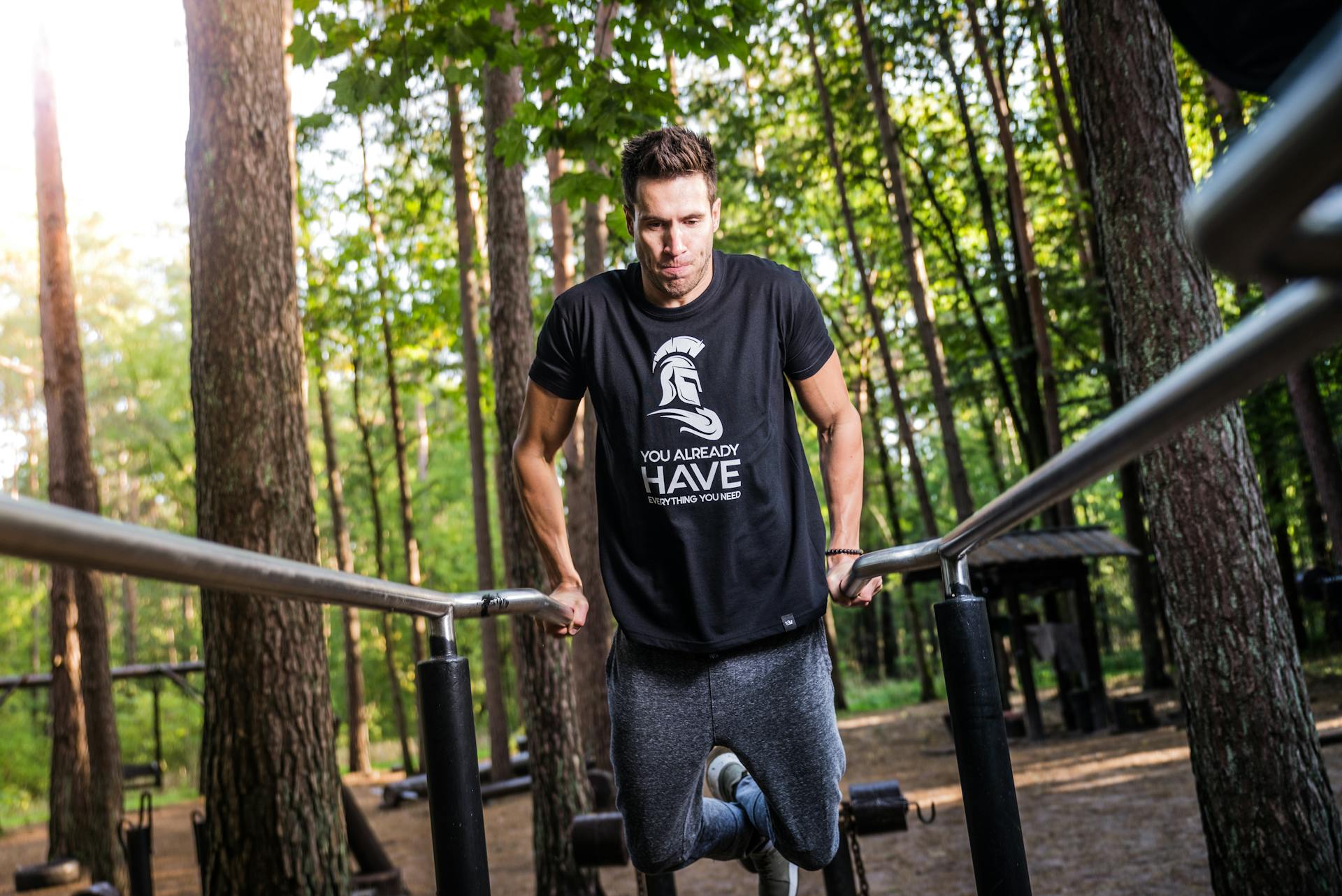A buff chest doesn’t just look magazine, gym, and beach-ready; strong chest muscles also give you better posture, support your upper back muscles, and improve your pushing power. Building a stronger and more defined chest requires engaging your lower pecs, which often takes a backseat. Plenty of exercises target the entire chest area, but you’ll need to incorporate movements that specifically work your lower chest for optimal results. It might take some time, but you can develop your major chest muscles with the right lower-pec-focused exercises. Read on for the best lower chest exercises to include in your routine.
Chest muscle anatomy
Your pectoralis major muscle in your chest is categorized into two different sections: the upper or clavicular area and the lower or sternal area. Exercises can emphasize the clavicular muscle fibers, the sternal muscle fibers, or both. For example, movements that involve bringing your arm up and across your body emphasize your upper chest muscle fibers that run diagonally down from your clavicle and out toward your arm.
As another example, movements that involve adducting your arm straight across your body better target the sternal area of your chest. The sternal area refers to the biggest of the two main sections of your lower and middle pectoral muscle. Many lower-chest building exercises also engage your serratus muscle, which works together with your lower chest, as well as your abdominal head of the pecs, which is found in the sternal area of your chest.
How to build your lower chest muscles

You’ll need to incorporate a variety of exercises that target these lower portions of your chest for the best outcome. The decline bench press is an excellent example because your arms are at a slightly lower than perpendicular angle to your body. The right angle and positioning of your arms in relation to your torso help fire up the sternal area of your chest muscles.
Your body fat levels will also need to be low enough to see muscle definition in your pecs. Several factors are involved, and weight loss and body fat composition are more complex. However, one of the ways to achieve lower body fat is through a healthier diet and a lower sugar intake.
How often should you train your lower chest?

Training your chest muscles two or three times per week is enough to generate results while still giving your muscles sufficient recovery time. It’s best to rest those muscles for at least one or two days in between sessions.
How many sets and reps should you do?

To start building muscle, you’ll need to perform two to three sets of 10 to 12 repetitions. You can increase the sets, reps, or weight over time to continue challenging and strengthening your muscles. You’ll also need to focus on perfecting your form, which lowers your risk of injury and maximizes muscle growth.
Why train the different sections of your chest?

Training different sections of your chest brings plenty of benefits. Chest exercises are often part of resistance training programs. For example, research shows upper body resistance training positively affects pulmonary function in male sedentary smokers. An impressive study revealed that strength training enhanced muscle strength and hypertrophy, muscle endurance, and quality of life for people with COPD or chronic obstructive pulmonary disease.
In another example, the chest fly machine increased body mass and bone density, so performing these exercises could be good news for your bones and athletic performance. Strength training and chest exercises like push-ups also burn calories.
The best lower chest workouts

Even just adding two or three of these chest-bulking exercises to your chest day or upper body training could make a big difference. Switch it up from time to time to keep it interesting and further enhance your results. These are hands down the best lower chest workouts.
Barbell bench press

Both the traditional bench press and the decline bench press hit your chest muscles. To do the decline bench press, you’ll just need to lie back on a decline bench instead of a flat bench. Research shows that just 2-3 months of bench press training in untrained participants caused a 10-20% increase in the muscle thickness of the chest muscles. Both versions of the bench press made our lower chest list because bench pressing hits your pectoralis major as well as your serratus anterior chest muscle located at the side of your chest from your upper ribs. You’ll also feel the burn in your triceps, biceps, and anterior deltoids.
How to do the barbell bench press:
- Lie on a flat bench and grip the barbell a little wider than the width of your shoulders.
- Press your feet into the ground, take a deep breath, and unrack the bar with an overhand grip.
- Carefully bend your elbows and lower the bar until it touches your chest.
- Push the bar back up and straighten your arms while you’re exhaling.
- Take another deep breath and repeat until the set is complete.
Decline dumbbell pullover

The dumbbell pullover is a simple yet effective exercise that targets your pecs in your chest, lat muscles in your back, triceps in your arms, posterior deltoids in your shoulders, and more. Both the traditional and the decline dumbbell pullover are an excellent choice for working your lower chest muscles. The decline might make the exercise more challenging because you can find more range of motion at your shoulders. More range of motion also stretches your chest and lats a little further.
How to do a decline dumbbell pullover:
- Hold one dumbbell with both hands and carefully recline yourself back onto the decline bench so you’re lying in a declined position on your back and looking up. Ideally, your head should be lower than your hips with the decline variation.
- Your feet should be flat on the floor, and the bench should support your head and upper back.
- Hold the dumbbell with both hands and straighten your arms up so the weight is above your chest in the starting position.
- Slowly take the weight back overhead as far as you can, bending your elbows and moving the weight until your upper arms are next to your ears.
- Return the weight back to the starting position.
- Repeat until the set is complete.
Cable crossover

If you have access to a cable machine, you can get a real pec workout with the cable crossover. Placing the handles in a higher position, usually above your head, allows you to better engage your lower chest muscles. You’ll also work your biceps and anterior deltoids.
How to do a cable crossover:
- Stand in front of the cable machine facing away from it and grip the handles. Take a step forward until you feel the cables are stretched.
- Try to keep your back straight. In the starting position, place one foot in front of the other with a slightly bent knee to help you keep your balance.
- Pull your hands together in an arcing motion in front of your body while squeezing your chest muscles. Your hands should almost touch each other at the top of the movement.
- Carefully move your arms back to the starting position.
- Repeat until the set is complete.
Top tip: Prioritize control and proper form and go at a steady pace rather than trying to accelerate your pace.
Incline push up

You can do an incline push-up if you have an elevated, stable surface, such as a bench or wall. You can change the difficulty of the exercise by increasing or decreasing the height of the surface. A higher surface brings the angle of your body more vertical, which decreases the difficulty of the movement. The incline push-up supercharges your lower chest muscles.
How to do an incline push-up:
- Stand facing the elevated surface and place both hands about shoulders-distance apart on the edge of the surface. Try to keep your arms extended and avoid locking your elbows in the starting position.
- Bend your elbows so they’re parallel to your body, and carefully lower your chest down until you touch the edge of the surface.
- Push your body away from the surface until your elbows are extended back in the starting position, but they aren’t fully locked.
- Repeat until you complete the set.
Top tip: A narrower grip generates better results, and a wider grip is easier to perform but puts more strain on your shoulders.
Chest dips

The chest dip is called the chest dip because it activates your chest, especially your lower chest area. You’ll also work all three heads of your triceps, your front deltoids, and your abs and core as you stabilize yourself to prevent your legs from swinging. This compound exercise made our list because research shows it involves a vertical pressing movement pattern that allows for a unique stimulation of the lower region of your pectoral muscles. You can also add belts, weighted vests, or chains to make it more challenging.
Here’s how to do a chest dip:
- Make sure the dipping bars or parallel bars are wider than shoulder-distance apart. A narrower grip won’t put as much emphasis on your chest muscles.
- Grip the bars with your palms facing inward.
- Try to make sure your chin is down and straighten your arms to support your body weight.
- Bend your knees and, try to tilt forward, and push your hips and legs back. A greater incline better activates your pecs.
- Bend your arms and lower yourself down with control to get a deep stretch of your pecs.
- Extend your elbows and push yourself back up to return to the starting position.
- Repeat until you complete the set.
Chest fly

As the name suggests, the chest fly is a single-joint exercise that fires up your pecs. A study highlights that dumbbell chest flys rely heavily on your pectoralis major, anterior deltoids, and biceps brachii to complete the movement. Dumbbell chest flys are chest openers because they open and stretch your chest muscles and maximize chest muscle gains in your upper and lower chest.
How to do a dumbbell chest fly:
- Lie on your back on a flat bench and make sure your feet are planted on the floor on either side of the bench. The bench should support your head and back throughout this exercise.
- Pick up the dumbbells and hold one in each hand with your arms out to the sides in the starting position.
- Carefully lift your arms up above your head to bring the dumbbells together in an arcing motion. Your arms should be extended, not locked, and your elbows should be slightly bent with your palms facing each other.
- Slowly lower the dumbbells back down to the starting position so they’re in line with your chest. Try not to drop your arms lower than your shoulders.
- Repeat until you complete the set.





